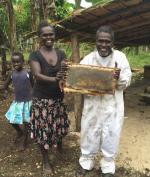Description
Urban beehives Provided by NRDF to provide the people of Solomon Islands a diverse source of income and a method to help forest restoration.
Nature-based solution type: Combination: Hybrid natural/engineered interventions, ecosystem restoration Ecosystem: Combination: Forest, created forest, urban greenery Climate change impacts targeted: Loss of ecosystem services, indirect health, social, cultural climate change impacts, loss of food production Societal challenges targeted: Biodiversity health and conservation, Food security and quality, Economic and social development Ecosystem services provided: Pollination, climate regulation, food production Summary: Urban beekeeping/beehive is the practice of placing bees and allowing them to thrive in the urban environment (Rutter, 2022). It involves housing colonies that has queens and worker bees, feeding them, and protecting them from various pests, and collecting honey when they become available (Rutter, 2022). While one may think that it would be more beneficial for bee colonies to be in the rural area where there is more greenery, studies have shown that bees find cities to be more vibrant pollinating environment, due to how cities have more plant species in parks, backyards, street trees, and playgrounds compared to the countryside (Rutter, 2022). Benefits: The practice of urban beekeeping can provide several benefits. Ecologically, bees play an important role as pollinators to a great number of flowering plant species, being the most dominant and effective pollinators, as well as providing a range of ecosystem services as pollinators, both directly and indirectly (Patel et al, 2020). One of the examples is bees pollinating wild plants in natural ecosystems and man-made crops, which provide a range of ecosystem services such as water cycle regulation, carbon sequestration, habitat provision (Brockerhoff et al, 2017), and food provision for both humans and wildlife as bees pollinate a range of food crops (Petal et al, 2020). As urban beekeeping involves providing environment for bees to thrive and multiply, the nature-based solution (Nbs) can provide such ecological benefits. It has been established above that bees are excellent pollinators which helps plants to reproduce and increase in numbers. This provides climate benefits as increase in plants and vegetation means more carbon dioxide released by humans can be absorbed by them, helping to reduce greenhouse gas emissions (NSW Government, n.d.). Also, with bees pollinating plant species in urban areas, more green infrastructures will be present throughout. This also provides range of climate benefits such as better stormwater management, reducing heat island effect, improving air and water quality (Lancharro et al, 2022). Also, Gebru et al (2016) points out that beekeeping can help to raise awareness of the communities on the importance of sustainable practices and managements, sparking different conversations, which could help to trigger community efforts to mitigate climate change. Culturally and socially, urban beekeeping can provide benefits as it helps to provide more greenery in urban settings. Patel et al (2020) states that urban beekeeping helps the community to connect to nature as more plants will be spread throughout the urban area, especially plants that are aesthetically pleasing such as variety of flowers. Economically, urban beekeeping provides benefits as they pollinate crops which helps them to increase in quality and quantity (Patel et al, 2020), and the range of different products that can be gained from beekeeping such as honey and wax gives many people economic benefits (Patel et al, 2020).
Opportunities, barriers, issues: As discussed above, urban beekeeping gives a range of opportunities regarding different areas such as ecological, cultural, economic, and climate. Urban beekeeping could not only help to improve our ecosystem and combat climate change, but improve poverty, economy, and people’s wellbeing by providing a variety of direct and indirect benefits. However, some of the barriers include not having enough spaces to keep beehives other than rooftops in urban environment, having too many people near the bees and their hives, and negative perceptions/fearing bees from the general public which is untrue (Rutter, 2022). ___Case Study: Natural Resources Development Foundation (NRDF)’s Forest for Life Project – providing urban beehives
Location: Solomon Islands When implemented: 2012 Ecosystem type: Forest & Grassland Climate adaptation: Loss of food production, loss of other ecosystem services, indirect health, social, cultural climate change impacts References / resources:
Bosma, W., Suti, S., & Deeks, P. (2017). Beekeeping as pro-forest income diversification in Solomon Islands. Climate Change Adaptation in Pacific Countries (pp. 371-387). Springer, Cham. https://link.springer.com/content/pdf/10.1007/978-3-319-50094-2_23.pdf Brockerhoff, E. G., Barbaro, L., Castagneyrol, B., Forrester, D. I., Gardiner, B., González-Olabarria, J. R., Lyver, P. O., Meurisse, N., Oxbrough, A., Taki, H., Thompson, I. D., Van Der Plas, F., & Jactel, H. (2017). Forest biodiversity, ecosystem functioning and the provision of ecosystem services. Biodiversity and Conservation, 26(13), 3005-3035. Gebru, Y. G., Gebre, A. E., & Beyene, G. (2016). Review on the role of honeybee in climate change mitigation and poverty alleviation. Livestock Res Rural Dev, 28(48). http://www.lrrd.org/lrrd28/3/yeti28048.htm Gulic, S. (n.d.). MendanaTutikera of Pine village, Solomon Islands harvests honey. With income from his bees, he pays the school fees for his granddaughter (pictured far left). USAID. https://medium.com/usaid-frontlines/super-bees-how-solomon-islanders-are-turning-to-these-tiny-heroes-to-help-save-their-forests-25e663083613 Lancharro, B. C., Chevalier, O., & Cordero, H. (2022, Mar 19). Urban Green Infrastructure: A Solution To Climate Challenges. Ciudades Sostenibles. https://blogs.iadb.org/ciudades-sostenibles/en/urban-green-infrastructure-a-solution-to-climate-challenges/#:~:text=The%20incorporation%20of%20UGI%20in,dampen%20noise%2C%20increase%20biodiversity%2C%20reduce NSW Government. (n.d.). Climate Change, Green Cover and Open Spaces. NSW Government. https://www.climatechange.environment.nsw.gov.au/green-cover-and-open-spaces#:~:text=Green%20cover%20and%20open%20spaces%20provide%20natural%20cooling%20of%20air,%2C%20drought%2C%20rainfall%20and%20storms Patel, V., Pauli, N., Biggs, E., Barbour, L., & Boruff, B. (2021). Why bees are critical for achieving sustainable development. Ambio, 50(1), 49-59. https://link.springer.com/article/10.1007/s13280-020-01333-9#citeas Rutter, B. (2022, Feb 16). Urban Beekeeping: History, Challenges, Benefits & Best Practices. Best Bees. https://bestbees.com/2022/02/16/urban-beekeeping/
Help us provide more detailed information about this project by contributing!
Images

About the author
DANIEL
• Submitted 1 projects
• Expert at Nature (Biodiversity)
• New Zealand
Websites
Related projects
Below you will find the latest related projects in this category.